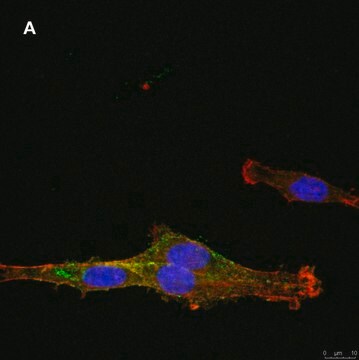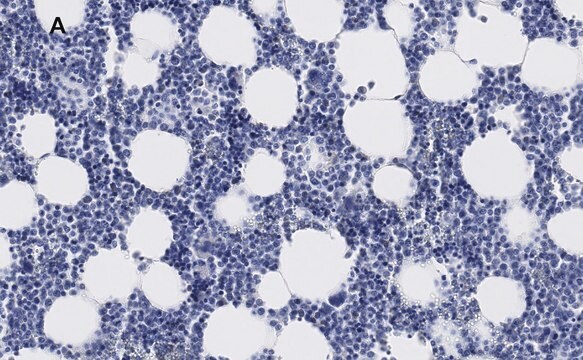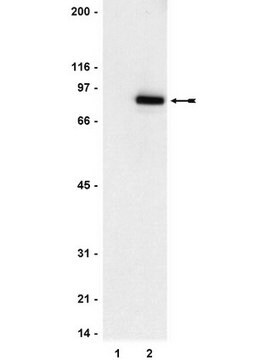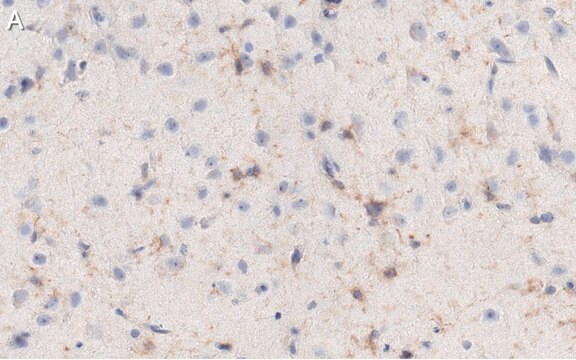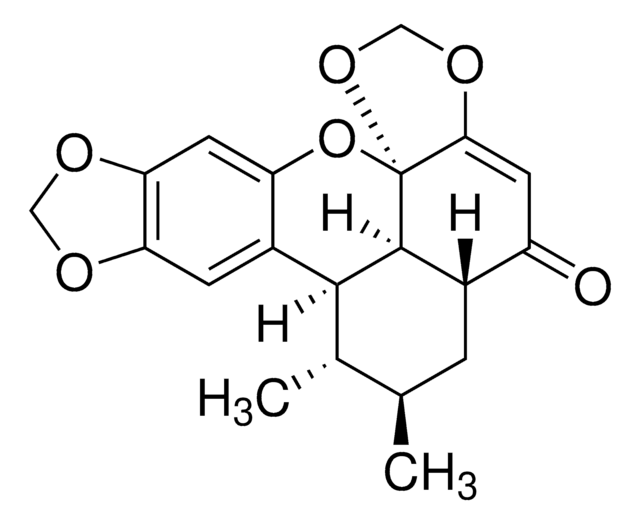일반 설명
We are committed to bringing you greener alternative products, which adhere to one or more of The 12 Principles of Green Chemistry.This antibody is Preservative-free, produced without the harm or sacrifice of animals and exceptionally stable to allow for ambient shipping and storage if needed and thus aligns with "Waste Prevention", "Designing Safer Chemicals" and "Design for Energy Efficiency".
Click here for more information.
ZooMAb® antibodies represent an entirely new generation of recombinant monoclonal antibodies.Each ZooMAb® antibody is manufactured using our proprietary recombinant expression system, purified to homogeneity, and precisely dispensed to produce robust and highly reproducible lot-to-lot consistency. Only top-performing clones are released for use by researchers. Each antibody is validated for high specificity and affinity across multiple applications, including its most commonly used application. ZooMAb® antibodies are reliably available and ready to ship when you need them.
특이성
Clone 4N22 is a Rabbit recombinant monoclonal antibody that specifically detects elf-2a phosphorylated on serine 51.
면역원
KLH-conjugated linear peptide corresponding to 13 amino acids surrounding phosphoserine 51 from the N-terminal region of human eIF-2a.
애플리케이션
Quality Control Testing
Evaluated by Western Blotting in lysate from HeLa cells treated with Calyculin A.
Western Blotting Analysis: A 1:10,000 dilution of this antibody detected phospho-eIF-2a -Ser51 in HeLa cells treated with Calyculin A (50 nM; 30 min).
Tested applications
Immunohistochemistry (Paraffin) Analysis: A 1:100 dilution from a representative lot detected phospho-eIF-2a -Ser51 in human prostate cancer tissue sections.
Peptide Inhibition Assay: Target band detection in lysate from HeLa cells treated with Calyculin A (50 nM; 30 min) was prevented by preblocking of a representative lot with phosphorylated eIF-2a -Ser51, but not with the corresponding non-phosphopeptide.
Immunocytochemistry Analysis: A 1:100 dilution from a representative lot detected phospho-eIF-2a -Ser51 in HeLa cells treated with Calyculin A.
Note: Actual optimal working dilutions must be determined by end user as specimens, and experimental conditions may vary with the end user
This rabbit monoclonal Anti-phospho-eIF-2a -Ser51, clone 4N22 ZooMAb® Rabbit Monoclonal, Cat. No. ZRB1419 is used in Western Blotting, Immunocytochemistry, Peptide Inhibition Assay and Immunohistochemistry, for the detection of phospho-eIF-2a -Ser51.
표적 설명
Eukaryotic translation initiation factor 2 subunit 1 (UniProt: P05198; also known as Eukaryotic translation initiation factor 2 subunit alpha, eIF-2-alpha, eIF-2A, eIF-2alpha) is encoded by the EIF2S1 (also known as EIF2A) gene (Gene ID: 1965) in human. eIF-2A is a heterotrimer composed of a, b, and g chains. It functions in the early steps of protein synthesis by forming a ternary complex with GTP and initiator tRNA. This complex binds to a 40S ribosomal subunit, followed by mRNA binding to form a 43S pre-initiation complex. In order for eIF-2 to recycle and catalyze another round of initiation, the GDP bound to eIF-2 must exchange with GTP by way of a reaction catalyzed by eIF-2B. Its activity is regulated by phosphorylation at serine 48 and serine 51 (without methionine), which stabilizes the eIF-2/GDP/eIF-2B complex and prevents the GDP/GTP exchange reaction, thus impairing the recycling of eIF-2 between successive rounds of initiation and leading to global inhibition of translation. elF-2A is reported to be a substrate for eukaryotic translation initiation factor 2-alpha kinase 1 to 4 (EIF2AK1, 2, 3, and 4). It is also a key component of the integrated stress response (ISR) and is required for adaptation to various stress conditions. Phosphorylation on serine 51 by the EIF2AK4 is shown to occur in response to amino acid starvation and UV irradiation. Its phosphorylation by EIF2AK1-4 converts it into a global protein synthesis inhibitor, leading to reduction in cap-dependent translation, while concomitantly initiating the preferential translation of ISR-specific mRNAs, such as the transcriptional activator ATF4. This ZooMAb® recombinant monoclonal antibody, generated by our propriety technology, offers significantly enhanced specificity, affinity, reproducibility, and stability over conventional monoclonals. (Ref.: Lee, YY., et al. (2009). J. Biol. Chem. 284(11); 6661-6673; Mikami, S., et al. (2006). Protein Expr, Purif. 46(2); 348-357).
물리적 형태
Purified recombinant rabbit monoclonal antibody IgG, lyophilized in PBS with 5% Trehalose, normal appearance a coarse or translucent resin. The PBS/trehalose components in the ZooMAb® formulation can have the appearance of a semi-solid (bead like gel) after lyophilization. This is a normal phenomenon. Please follow the recommended reconstitution procedure in the data sheet to dissolve the semi-solid, bead-like, gel-appearing material. The resulting antibody solution is completely stable and functional as proven by full functional testing. Contains no biocide or preservatives, such as azide, or any animal by-products. Larger pack sizes provided as multiples of 25 μL.
저장 및 안정성
Recommend storage of lyophilized product at 2-8°C; Before reconstitution, micro-centrifuge vials briefly to spin down material to bottom of the vial; Reconstitute each vial by adding 25 μL of filtered lab grade water or PBS; Reconstituted antibodies can be stored at 2-8°C, or -20°C for long term storage. Avoid repeated freeze-thaws.
법적 정보
ZooMAb is a registered trademark of Merck KGaA, Darmstadt, Germany
면책조항
Unless otherwise stated in our catalog or other company documentation accompanying the product(s), our products are intended for research use only and are not to be used for any other purpose, which includes but is not limited to, unauthorized commercial uses, in vitro diagnostic uses, ex vivo or in vivo therapeutic uses or any type of consumption or application to humans or animals.

